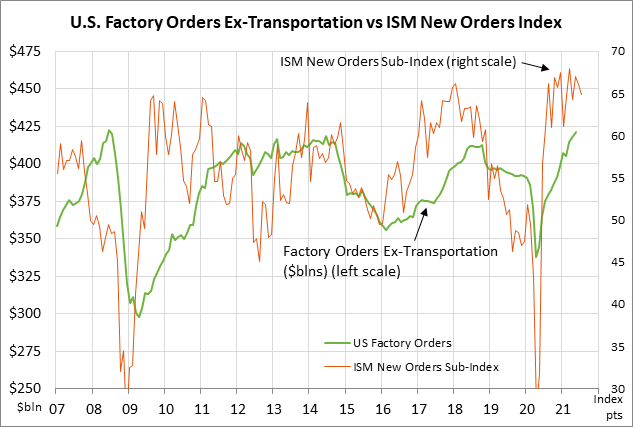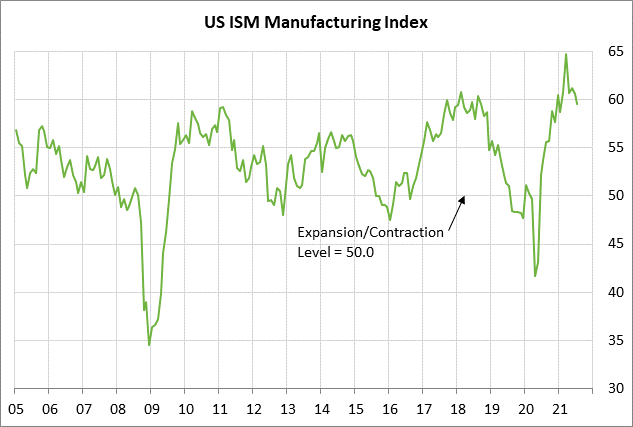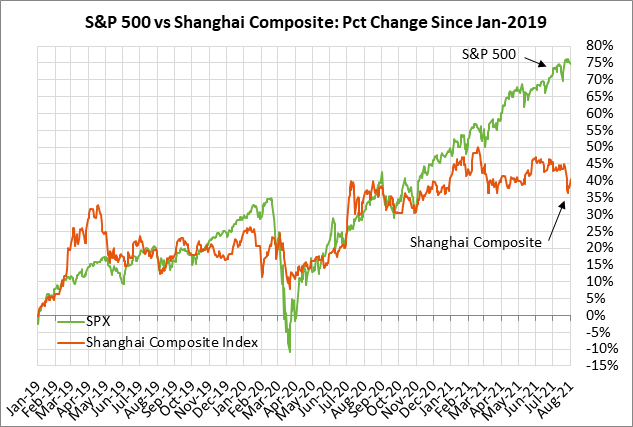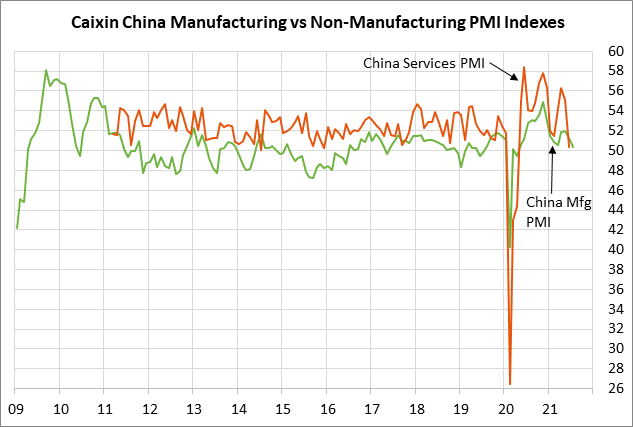- U.S. factory orders expected to show continued strength
- Chinese stocks on Monday recover as the government pledges support
- Chinese PMI reports indicate slow easing in Chinese economy
U.S. factory orders expected to show continued strength — The consensus is for today’s June factory orders report to show an increase of +1.0% m/m. That would follow the May report of +1.7% m/m and +0.7% m/m ex-transportation.
U.S. factory orders continue to see a heavy influx as companies and consumers play catch-up after last year’s pandemic shutdowns. May factory orders were up +30.4% y/y on a year-on-year basis and were 7.1% higher than the pre-pandemic level, illustrating that the recent strength in factory orders is not simply due to the low year-earlier base.
While orders are flooding into the manufacturing sector, companies are having trouble filling those orders due to supply chain and labor constraints. U.S. manufacturing production in June fell by -0.1% m/m and was up by only +1.6% on a 3-month annualized basis.
Yesterday’s July ISM manufacturing index fell by -1.1 points to 59.5, which was the second consecutive monthly decline. The decline was attributed in part to the difficulties that companies are having with producing goods due to the chip shortage and the shortage of some raw materials and components. Also, some companies are having trouble ramping up production due to the problem of quickly hiring enough qualified new employees.


Chinese stocks on Monday recover as the government pledges support — The Shanghai Composite Index on Monday rallied sharply by +1.97%, recovering farther from last week’s 8-3/4 month low.
Chinese stocks on Monday rallied after the Politburo at its meeting last Friday promised additional targeted support for China’s economy. However, Chinese authorities also lectured China’s largest technology companies on data security, vowed better oversight of overseas IPOs, and accused ride-hailing companies of stifling competition.
Starting this year, Chinese President Xi Jinping began a “new development phase†that puts three priorities ahead of economic growth. First is national security, which includes control of data and more self-reliance on technology. Second is “common prosperity,†which aims to curb inequalities that have arisen in China’s economy in recent decades. Third is stability within China’s society, which means tamping down discontent among China’s middle class.
The events of recent weeks, where several sectors of China’s economy have been hit by new regulations, show the Chinese government is focusing on common prosperity. For decades, Chinese leaders kept strict control over strategic sectors like banking and oil and gave entrepreneurs and investors the freedom to adopt new technologies and spur new opportunities for growth.
Former Chinese leader Deng Xiaoping set the tone back in the mid-1980s when he said it was acceptable if some Chinese citizens got rich. However, with slowing economic growth and hostile relations with the U.S., China’s Communist government is now emphasizing different goals as it tries to ensure the continued existence of its hybrid economic system.
Chinese President Xi Jinping’s commitment to a sweeping new vision for China means that investors are taking a back seat to social stability and national security. Chinese leaders believe the economy will thrive only through state planning, even if that threatens the interests of entrepreneurs and investors.
In response to China’s clampdown on private industry, SEC Chair Gary Gensler said last Friday that the SEC would halt initial public offerings of Chinese companies until they increase disclosure of risks posed to shareholders. China’s Securities Regulatory Commission responded on Sunday by saying it seeks to step up communication with the SEC to find a suitable resolution.
The recent crackdown by Chinese regulators has triggered a sell-off in Chinese stocks as the Shanghai Composite tumbled to an 8-3/4 month low last Wednesday, with losses in Chinese technology and education stocks soaring past $1 trillion since February.

Chinese PMI reports indicate slow easing in Chinese economy — The Chinese stock market on Monday was able to shake off the negative effects of last Friday night’s Chinese July PMI reports, which showed small declines as China’s post-pandemic economic surge fades.
The Chinese July manufacturing PMI fell by -0.5 to 50.4, which was a larger decline than expectations of -0.1 point. The July non-manufacturing PMI fell by -0.2 point to 53.3, which was in line with market expectations.
The Caixin China manufacturing PMI on Monday night then fell by -1.0 point to 50.3, which was weaker than the consensus for a -0.3 point decline to 51.0. The consensus is for Tuesday night’s July Caixin China services PMI to show a +0.2 point increase to 50.5, stabilizing after June’s sharp -4.8 point drop to 50.3.
The consensus is for Chinese GDP to ease from +7.9% y/y in Q2 to +6.0% in Q3 and +5.0% in Q4. GDP growth is then expected to stabilize near +5.6% in 2022.


